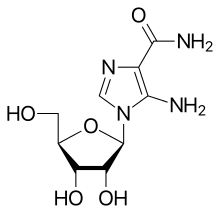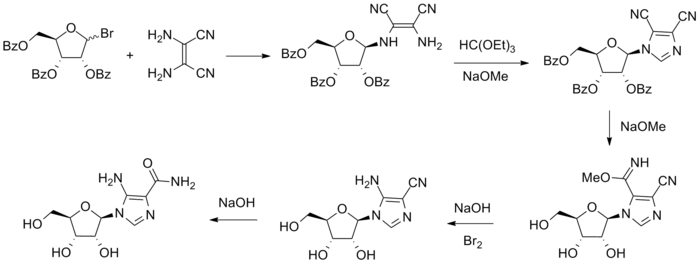Acadesine
Acadesine (INN), also known as 5-aminoimidazole-4-carboxamide-1-β-D-ribofuranoside, AICA-riboside, and AICAR, is an AMP-activated protein kinase activator[1] which is used for the treatment of acute lymphoblastic leukemia[2] and may have applications in treating other disorders such as diabetes.[3]
 | |
| Clinical data | |
|---|---|
| ATC code | |
| Identifiers | |
| |
| CAS Number | |
| PubChem CID | |
| IUPHAR/BPS | |
| ChemSpider | |
| UNII | |
| KEGG | |
| ChEBI | |
| ChEMBL | |
| CompTox Dashboard (EPA) | |
| ECHA InfoCard | 100.018.271 |
| Chemical and physical data | |
| Formula | C9H14N4O5 |
| Molar mass | 258.234 g·mol−1 |
| 3D model (JSmol) | |
| |
| |
| | |
Acadesine is an adenosine regulating agent developed by PeriCor Therapeutics and licensed to Schering-Plough in 2007 for phase III studies. The drug is a potential first-in-class agent for prevention of reperfusion injury in CABG surgery. Schering began patient enrollment in phase III studies in May 2009. The trial was terminated in late 2010 based on an interim futility analysis.[4][5]
Chemistry
Reaction of 2-bromo tribenzoyl ribose with diaminomaleonitrile results in the displacement of the anomeric halogen by one of the amino groups and the formation of the aminosugar largely as the β-anomer. Treatment of this product with methyl orthoformate in the presence of a base leads to the replacement of the alkoxy groups in orthoformate by the adjacent amines, resulting in the formation of the imidazole ring. Reaction with alkoxide then converts the nitrile nearest the sugar to an iminoester; the benzoyl groups are cleaved in the process. Hofmann rearrangement in the presence of a bromine and a base converts the iminoester to the corresponding primary amine. Basic hydrolysis then converts the remaining nitrile to an amide, affording acadesine.[6]

Pharmacology and use in doping
Acadesine acts as an AMP-activated protein kinase agonist.[7] It stimulates glucose uptake and increases the activity of p38 mitogen-activated protein kinases α and β in skeletal muscle tissue,[8] as well as suppressing apoptosis by reducing production of reactive oxygen compounds inside the cell.[9]
In 2008, researchers at the Salk Institute discovered that acadesine injected in mice significantly improved their performance in endurance-type exercise, apparently by converting fast-twitch muscle fibers to the more energy-efficient, fat-burning, slow-twitch type. They also looked at the administration of GW 501516 (also called GW1516) in combination with acadesine. Given to mice that did not exercise, this combination activated 40% of the genes that were turned on when mice were given GW1516 and made to exercise. This result drew attention to the compound as a possible athletic endurance aid.[10] One of the lead researchers from this study has developed a urine test to detect it and has made the test available to the International Olympic Committee, and the World Anti-Doping Agency (WADA) has added acadesine to the prohibited list from 2009 onwards.[11] The British Medical Journal reported in 2009 that WADA had found evidence that acadesine was used by cyclists in the 2009 Tour de France.[12]
References
- Favero, Carlita B.; Mandell, James W. (2007). "A pharmacological activator of AMP-activated protein kinase (AMPK) induces astrocyte stellation". Brain Research. 1168: 1–10. doi:10.1016/j.brainres.2007.06.087. PMC 2000700. PMID 17706943.
- Cronstein, BN; Kamen, BA (2007). "5-aminoimidazole-4-carboxamide-1-beta-4-ribofuranoside (AICA-riboside) as a targeting agent for therapy of patients with acute lymphoblastic leukemia: are we there and are there pitfalls?". Journal of Pediatric Hematology/Oncology. 29 (12): 805–7. doi:10.1097/MPH.0b013e31815bbb83. PMID 18090925.
- Cuthbertson, D. J.; Babraj, J. A.; Mustard, K. J. W.; Towler, M. C.; Green, K. A.; Wackerhage, H.; Leese, G. P.; Baar, K.; Thomason-Hughes, M.; Sutherland, C.; Hardie, D. G.; Rennie, M. J. (2007). "5-Aminoimidazole-4-Carboxamide 1- -D-Ribofuranoside Acutely Stimulates Skeletal Muscle 2-Deoxyglucose Uptake in Healthy Men". Diabetes. 56 (8): 2078–2084. doi:10.2337/db06-1716. PMID 17513706.
- https://www.reuters.com/article/pressRelease/idUS115105+11-May-2009+PRN20090511
- https://www.sec.gov/Archives/edgar/data/310158/000095012310074336/y83714e10vq.htm#002
- Ferris, James P.; Devadas, Balekadru; Huang, Chun Hsien; Ren, Wu Yen (1985). "Nucleosides from carbohydrate adducts of diaminomaleonitrile. A novel synthesis of 5-amino-1-(.beta.-D-ribofuranosyl)imidazole-4-carboxamide and 5-amino-1-(.beta.-D-ribopyranosyl)imidazole-4-carboxamide". The Journal of Organic Chemistry. 50 (6): 747. doi:10.1021/jo00206a004.
- Corton JM, Gillespie JG, Hawley SA, Hardie DG (April 1995). "5-aminoimidazole-4-carboxamide ribonucleoside. A specific method for activating AMP-activated protein kinase in intact cells?". Eur. J. Biochem. 229 (2): 558–65. doi:10.1111/j.1432-1033.1995.0558k.x. PMID 7744080.
- Lemieux K, Konrad D, Klip A, Marette A (September 2003). "The AMP-activated protein kinase activator AICAR does not induce GLUT4 translocation to transverse tubules but stimulates glucose uptake and p38 mitogen-activated protein kinases alpha and beta in skeletal muscle". FASEB J. 17 (12): 1658–65. doi:10.1096/fj.02-1125com. PMID 12958172.
- Kim JE, Kim YW, Lee IK, Kim JY, Kang YJ, Park SY (March 2008). "AMP-activated protein kinase activation by 5-aminoimidazole-4-carboxamide-1-beta-D-ribofuranoside (AICAR) inhibits palmitate-induced endothelial cell apoptosis through reactive oxygen species suppression". J. Pharmacol. Sci. 106 (3): 394–403. doi:10.1254/jphs.FP0071857. PMID 18360094.
- Narkar VA, Downes M, Yu RT, Embler E, Wang YX, Banayo E, Mihaylova MM, Nelson MC, Zou Y, Juguilon H, Kang H, Shaw RJ, Evans RM (August 2008). "AMPK and PPARδ agonists are exercise mimetics". Cell. 134 (3): 405–15. doi:10.1016/j.cell.2008.06.051. PMC 2706130. PMID 18674809.
- WADA 2009 Prohibited List Archived 2009-02-03 at the Wayback Machine
- Benkimoun, P. (2009). "Police find range of drugs after trawling bins used by Tour de France cyclists". BMJ. 339: b4201. doi:10.1136/bmj.b4201. PMID 19825964.